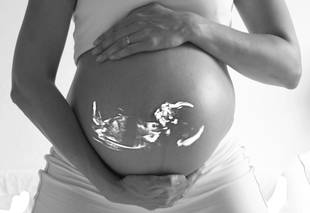
When does human life begin? How can it be protected?
Individual life can be said to begin when the female ovum is fertilized by the male sperm. At this moment of conception we have the zygote. This single fertilized cell divides into many cells, thus the bone cells, the hair cells, and all types of cells develop which gradually assume specialized forms and functions. In this state, we speak of the embryo which lasts until around the second month of prenatal life and which takes a human form. From this time, it is called a fetus. Behavior begins with bodily movements at about the beginning of the fetal period, some 8-9 weeks after fertilization.
What is the stand of the church on upholding and protecting human life?
Pope John Paul II's latest encyclical, Evangeline Vitae, reaffirms in no uncertain terms the stand of the church on upholding the value of human life from the moment of conception until its last breath on earth.
It condemns the use of contraceptives, the practice of abortion and mercy killing or euthanasia. It asserts that life is a sacred gift from God, that it can be nourished to the fullest, be protected from all harms and abuses, taken cared of and comforted in its dying days. God is the source of life and is the only one who can take it away, the way He wants it. The death penalty imposed by the State is something the church frowns upon.
How is development from prenatal to the newborn infant explained?
The fetal development follows the same general principles that operate in lower animals. Behavior develops in close relationship tp the growth of the nervous system. In physical growth during the second month, the head constitutes half of the total body which becomes proportionately smaller and rounder as age increases. The various sensory and motor functions appear first in the head region of the fetus, and progressively pass to the regions farther from the head.
The growth of behavior follows a sequence of development from general to specific, from central to paripheral. Some reflexes are present at birth; others appear months after birth. Example: the sucking reflex present at birth which is elicited by touching the lips or cheek. When the sole of the newborn infant's foot is scratched by the fingers, the response that follows is one of a disorganized extension of toes which is called Babinski reflex. The big too extends outward and upward, while the other toes spread out in a fanlike shape.
What sense organs function actively at birth?
There is some development of the child's sense organs before birth. Studies show that at birth the newborn can make vidual discriminations between lights of different brightness and colors but not so well as adults do. They are also sensitive to taste, smell, sound and pain. They allow responses to changes in temperature. Hunger and thirst also function well in the newborn. The senses of movement and balance are also present.
Motor coordination follows a sequence from general to specific, and from head-to-toe. This is seen in the development of prehension or grasping and locomotion.
Speech is a sensory-motor reaction which becomes language when meaning becomes attached to words, that is, when words become symbol for persons, objects, and situations. The mechanisms of vocal response are partially developed at birth, as shown by the "birth cry" of every newborn infant.
How is the development from genral to specific movements and from head-to-toe seen?
This is seen in the acquisition of habits of walking as shown in the development of posture and locomotion in infants
| 0 month: | fetal posture |
| 1 month: | chin up |
| 2 months: | chest up |
| 3 months: | reach and miss |
| 4 months: | sit with support |
| 5 months: | sit on lap, grasp object |
| 6 months: | sit on high chair, grasp dangling object |
| 7 months: | sit alone |
| 8 months: | stand with help |
| 9 months: | stand holding furniture |
| 10 months: | creep |
| 11 months: | walk when led |
| 12 months: | pull to stand by furniture |
| 13 months: | climb stair by furniture |
| 14 months: | stand alone |
| 15 months: | walk around by himself |
These figures are estimated on the average. Some children go through these sequences earlier and others at later ages.
Human beings are the most immature at birth of all mammals. They require the longest period of development before they are capable of all the activites and skills characteristic of their species. The nervous system of human beings is so complex that requires the longest time to reach maturity of all organisms. As compared with other organisms, the human offspring requires the longest period of learning and interaction with others for its full development.
How may the saying, "the child is father of the man" be explained? What are its complications?
Adults' behavior and personality characteristics are influenced by events that occur during the early years of life. The psychological processes of human adults which include perceptions, patterns of thinking, motives, emotions, conflicts, and ways of coping with conflicts have their origin which need to be known including the change over time. All these reflect the need to be known including the change over time. All these reflect the continuity of psychological processes between childhood and adulthood. It is of practical importance to everyone to know how early experience mold an individual. This knowledge may make us wiser in the way we bring up our children. Many problems that confront society like aggression, vandalism, suicide, mental illness, to mention a few, could perhaps be minimized if we understood better how parental behavior or attitudes affect children.
The child is the starting point of evolution. This shows the importance of the part of childhood stage. Hence the child should not be taken for granted but should be meticulously guided to full development because the progress of any life activity of the present is dependent upon the child produced during the formative years. Thus, "the child is father of the man." "No other success can compensate for the failure in the home," David Mckay.
What factors govern development?
Human development involves a continuous interaction between biological predisposition determined by ones genes, heredity, and the experiences encountered while growing up in a particular family, culture, and environment. The genetic determinants express themselves through the process of maturation. Maturation refers to the growth processes in the individual that result in orderly changes in behavior. The timing and patterning of these changes are relatively independent of exercise or experience though they may require a normal environment. We say "relatively" because such changes occur over a wide range of environmental conditions. If the environment is inadequite in some way maturational processes can be disrupted. Maturation is most apparent during childhood but it continues into adult life. Changes are regulated by a biologically determined time schedule.
How may the sequence and stages in development be describe?
1. Natural sequence
Infants reach for an object before they are able to pick it up. We learn to walk before was run. We learn to speak words before we could express our ideas into sentences. We learn to count by rote before we understand the concept of numbers.
2. Simple to complex
Sequences in development usually proceed from simple behavior to those that are more differentiated and complex. Newborn infants can close and often their fingers and occasionally managing to connect the thumb with the mouth. As they mature these simple actions become differentiated into more complex behaviors as in patting an object, grasping it, moving it toward the mouth or throwing it away.
3. Orderly and a continuos process
The orderly sequences in development depend on maturation of the organism as it interacts with its environment.
4. A series of steps
The life span has broad stages of successive periods of infancy, childhood, adolescence, and adulthood. The concept of stage in development implies that:
1) behaviors at a given stage are organized around a dominant theme.
2) behaviors at one stage are qualitatively different from behavior that show at earlier or later stages.
3) all children go through the same stagesin the same order.


















